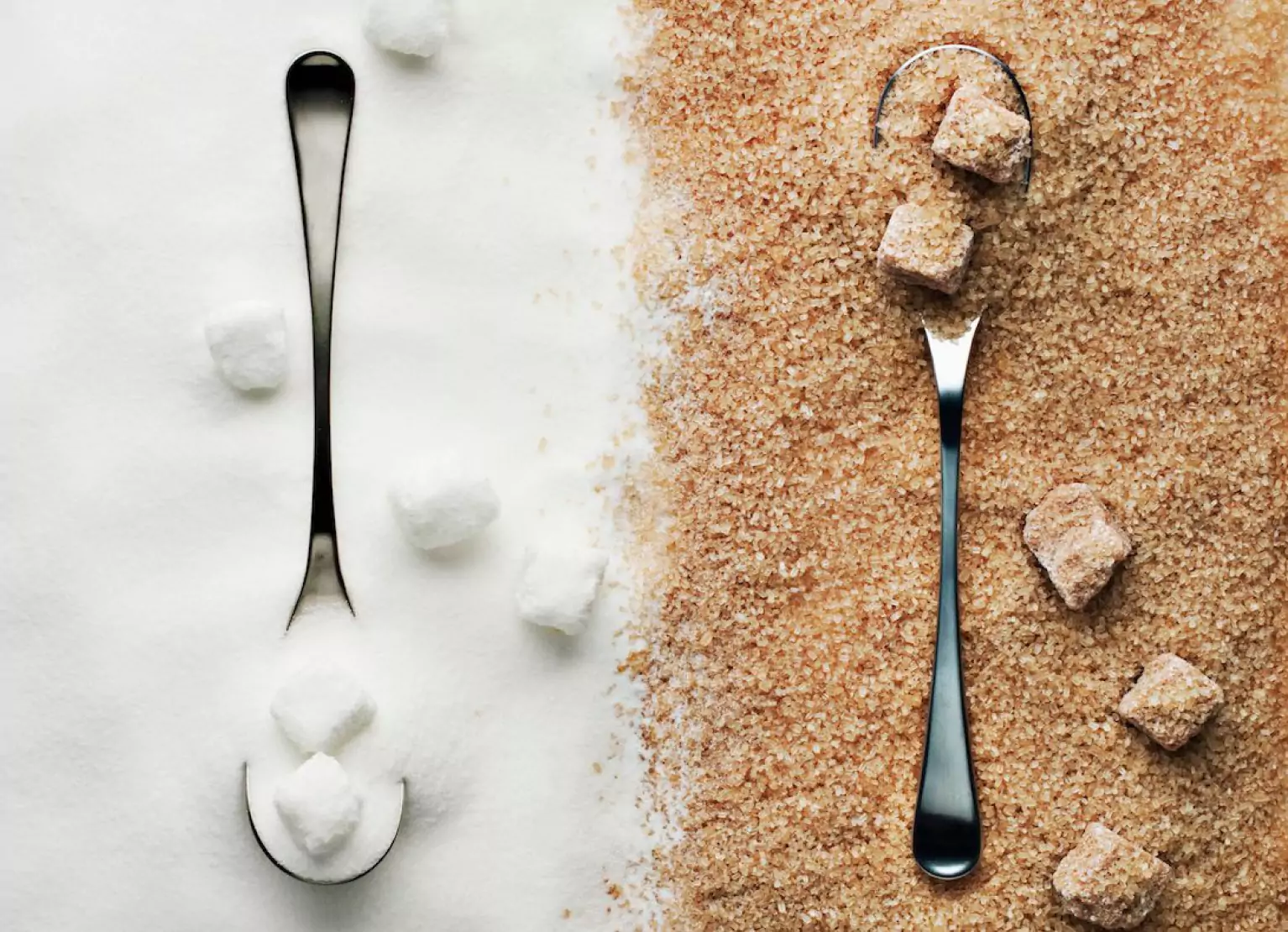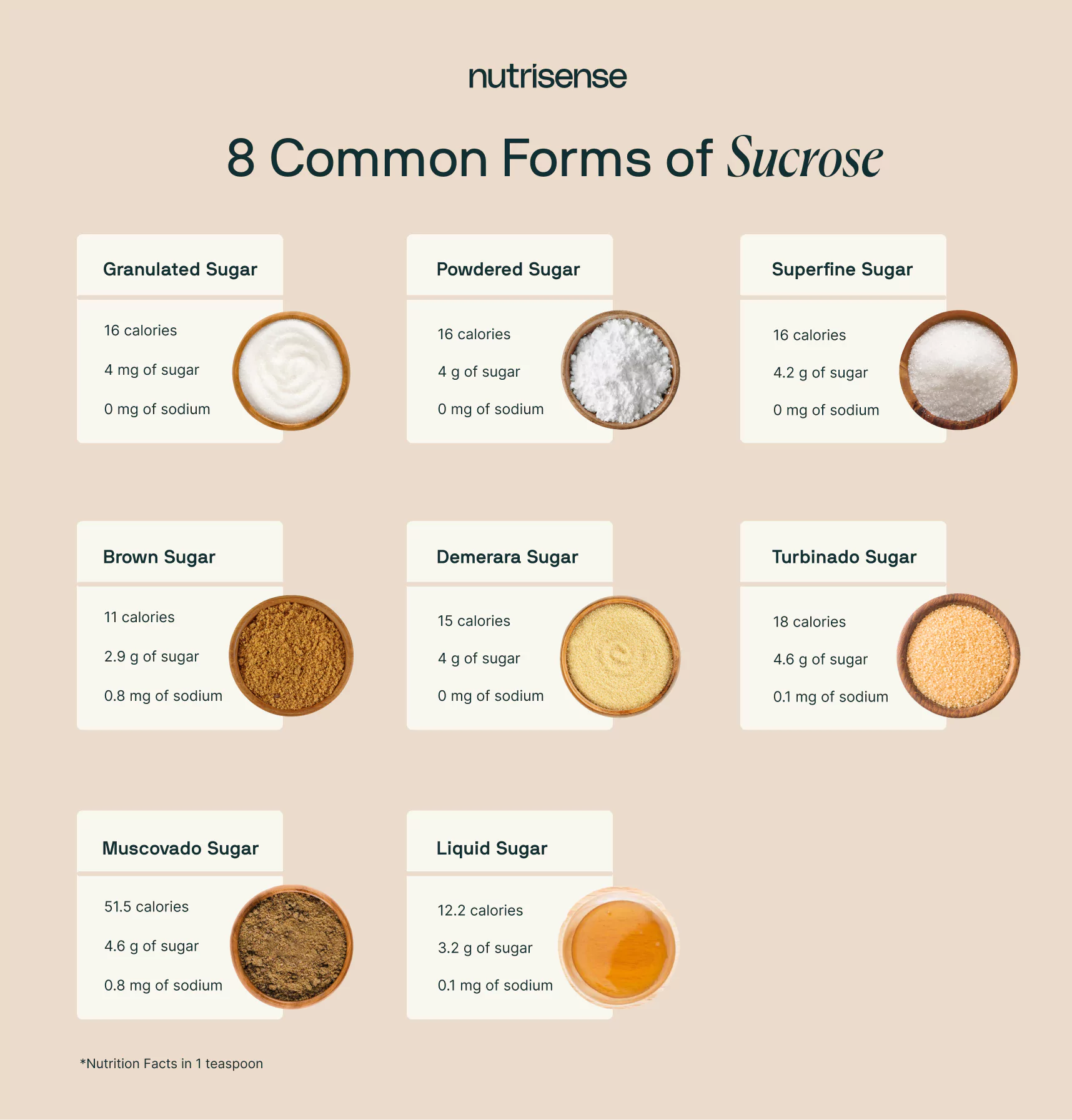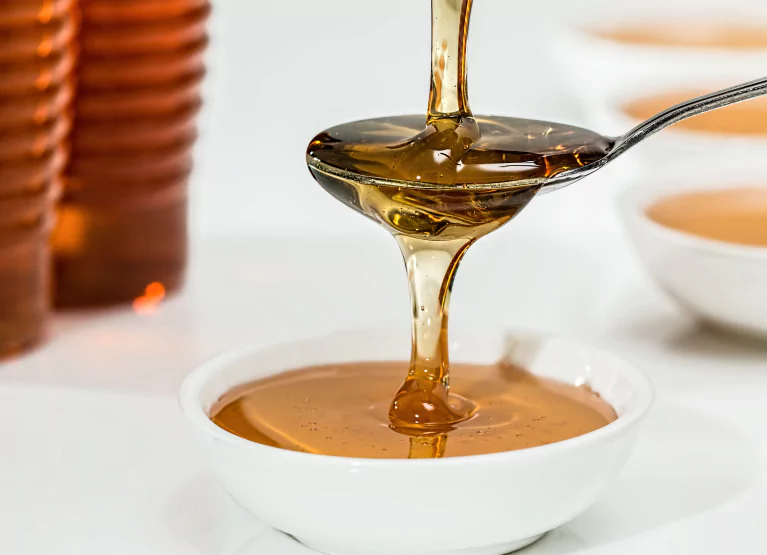A Guide to the Different Types of Sugar
.webp)
Key Takeways
We talk a lot about the way sugar affects our bodies, but how much do we know about sugar itself? Sugar is found in many forms and is hard to totally avoid. But is all sugar bad for you? And how many types of sugar are there?
Read on to learn more about the different kinds of sugar, how they're used, and how they may affect your health.
What is Sugar?
The type of sugar that you generally think of as "table sugar" is called sucrose. Sucrose is a carbohydrate known as a disaccharide, and it's made up of one molecule of glucose bound to one molecule of fructose.
Sugar is found naturally in plants, including fruits, vegetables, and grains. It's made during photosynthesis as plants transform the sun's energy into food. Sugar cane and sugar beets are the two plants that hold the most sugar, so most commercial sugar is extracted from these two plants.
The extraction process for making most sugars involves pressing the plant to release juice. The juice is concentrated and crystalized, then spun to separate the liquid, or molasses, from the crystals. The amount of molasses left on the sugar crystals depends on the type of sugar.
Granulated sugar has no molasses left after refining, but raw sugars like demerara or turbinado have some molasses left over. Some varieties, like brown sugar, have the molasses added back in after the refining process.
What are the Different Types of Sugar?

Sugars can be divided into various groups. Monosaccharides and disaccharides, which consist of one and two sugar units, respectively, are both forms of simple carbohydrates.
Oligosaccharides and polysaccharides are each forms of complex carbohydrates, and they're made up of three to 10 units of sugar and greater than 10 units of sugar, respectively. Let's review the two types of simple carbohydrates and which types of sugar fall into each.
Monosaccharides
Monosaccharides, or simple sugars, are the basic compounds that make up all carbohydrates. Glucose, fructose (the sugar in fruit), and galactose are the three main monosaccharides found in the food we eat. Glucose and fructose are found naturally in plants, while galactose comes from milk.
Disaccharides
Disaccharides are sugars that contain two monosaccharides linked together, such as sucrose or maltose. Sucrose is a disaccharide because it contains one molecule of fructose (also known as fruit sugar) bonded to one glucose molecule.
Lactose, a sugar found in milk and many other dairy products, is a disaccharide that contains one molecule of galactose and one molecule of glucose bonded together.
8 Common Forms of Sucrose

Sucrose is a common source of added sugar, but it comes in many forms. However, because all of these sugars are made of sucrose, which is made up of equal parts glucose and fructose, they're all metabolized by your body in the same way.
Here are eight of the most common types of sucrose and how they're used.
1) Granulated Sugar
Granulated sugar, also known as white sugar, table sugar, regular sugar, and sometimes caster sugar, is the most common sugar used in baking. It's also commonly used to sweeten hot beverages like coffee and tea.
This type of sugar is made from sugar cane juice. After being extracted from the sugar cane plants, the juice is filtered to remove dirt and then boiled into a syrup and spun to separate the crystals.
It's then liquefied again and processed to remove any remaining color. The crystals are separated again and ground into fine, white crystals.
2) Powdered Sugar
Powdered sugar, also known as confectioner's sugar or icing sugar, dissolves easily, so it's often used in frosting and icing. This sugar is granulated sugar that's ground into a powder. Commercial powdered sugar is often mixed with cornstarch to prevent caking.
3) Superfine Sugar
Superfine sugar is made by grinding granulated sugar into finer crystals. It is commonly used in baked goods, desserts like mousse or pudding, and as a sweetener for beverages. It's also ideal for making meringues.
4) Brown Sugar
Both light and dark varieties of brown sugar are made by mixing white sugar with molasses, the syrup that remains after the sugar is crystallized. This type of sugar is used in baked goods, oatmeal, baked beans, and sauces such as barbecue sauce.
5) Demerara Sugar
Demerara sugar is a minimally processed sugar made by dehydrating cane sugar syrup after it's extracted from sugar cane. It generally has bigger crystals than white sugar or brown sugar, with a light brown or gold tint.
This sugar can be used in baked goods, to sweeten beverages, or sprinkled on top of desserts like crème brûlée to add crunch.
6) Turbinado Sugar
Turbinado sugar, also known as raw sugar, is similar to demerara. It is a partially processed sugar that has only had the top layer of molasses washed off. It has large, light brown crystals.
This sugar can be used in baked goods, as a sweetener for hot beverages, and as a crunchy topping for desserts.
7) Muscovado Sugar
Muscovado sugar is also known as Barbados sugar. Unlike brown sugar, which is refined white sugar with molasses mixed back in, muscovado sugar is an unrefined sugar in which the molasses has never been removed.
This sugar is dark brown and has coarse, almost sandy crystals. It can be used in desserts and savory dishes similar to brown sugar, but it has a deeper flavor.
8) Liquid Sugar
This type of sugar is also known as simple syrup. Liquid sugar is made from granulated sugar dissolved in water. Because the sugar has already been dissolved, it's perfect for sweetening cold beverages like iced coffee, iced tea, and cocktails.
Natural Sugar vs. Added Sugar

Sugar that's naturally found in food is called natural sugar. These sugars come from milk, fruits, grains, and vegetables, providing all kinds of nutrients your body needs to function correctly.
Sugar from natural sources is an essential part of a healthy diet, as recommended by the Dietary Guidelines of America. Natural sources of sugar can also include things like fiber, phytochemicals, and essential vitamins and minerals.
Added sugar, as we recently discussed, is sugar that's been added to a food or beverage after it's been produced or prepared. A diet high in added sugars can increase your chance of developing both prediabetes and type 2 diabetes, chronic inflammation, high blood pressure, and obesity.
Studies have shown that a diet high in added sugar can make you three times as likely to die from heart disease and fatty liver disease. The American Heart Association recommends limiting your added sugar consumption to six percent or less of your total daily calories.
Types of Added Sugar
Added sugar comes in many forms. Examples include various types of sugars and syrups usually used for cooking and baking, such as granulated sugar, brown sugar, simple syrup, and powdered sugar.
Here are some other examples of added sugars:
High-Fructose Corn Syrup

High-fructose corn syrup (HFCS) is a sweetener commonly found in many heavily processed food products and sugary drinks, such as soft drinks and energy drinks. It's made from cornstarch. Starch contains glucose, and when broken down into individual glucose molecules, it turns into corn syrup that's 100 percent glucose. Certain enzymes convert some of the glucose into fructose when added to corn syrup.
The end product of this process is high-fructose corn syrup. HFCS is found in many products, such as soda, juice, breakfast cereal, pancake syrup, jams, and candy. It's been associated with a higher risk for type 2 diabetes and insulin resistance, obesity, cardiovascular disease, and an increased risk of developing gout and kidney stones.
Honey
Honey is a sweet syrup made from the nectar of plants and flowers. It contains fructose, glucose, maltose, and sucrose and can even contain other types of sugar, depending on the plant from which the bees collected it.
Though honey is a source of added sugar, it also contains vitamins, minerals, and antioxidants that may benefit your health.
Agave Nectar

Agave syrup, also called agave nectar, is a concentrated form of the fluid found inside the agave plant, a cactus native to Mexico. It's mostly fructose and some glucose. Unlike glucose, which is processed by nearly every cell in the body, fructose is mainly metabolized in the liver. Over time, high fructose intake can burden the liver and lead to fat accumulation, increasing the risk of insulin resistance and type 2 diabetes.
Studies have shown that a diet high in fructose may increase your chance of developing insulin resistance and type 2 diabetes.
Maple Syrup
Maple syrup has always been promoted as a healthier, natural alternative to refined sugar. Made from the sap of maple trees, it contains nutrients like calcium, potassium, and zinc.
However, it's still high in sucrose and should be consumed in moderation. Some studies have also shown that consuming too much maple syrup may negatively affect blood sugar levels and contribute to weight gain.
Another problem with maple syrup is that there are so many fake products on the market, making it difficult to know if you are getting 100% pure maple syrup or a blend of other ingredients. Reading the food labels and buying from reputable food manufacturers is important.
5 Dietitian-Approved Tips to Help Reduce Your Sugar Intake
The dietitian and nutrition team here at Nutrisense recommends the following general tips for anyone who wants to optimize their overall health and reduce their sugar intake.
1) Minimize your consumption of added sugars. The American Heart Association recommends that adults limit added sugars to:
- Men: No more than nine teaspoons (36 grams or 150 calories) per day
- Women: No more than six teaspoons (25 grams or 100 calories) per day
2) Choose whole fruit over processed fruits and sugary beverages, and avoid fruits with added sugar or other caloric sweeteners.
3) Pair your sugary or starchy foods with protein and consider eating protein first to help keep blood sugar more balanced.
4) Time your carb or sugar consumption around times of higher physical activity during your day or earlier in the day
5) Test out different amounts and types of sugar to see what works best for your unique body.
Find the right Nutrisense programto turn insight into progress.
Go Beyond Glucose Data with Nutrisense
Your glucose can significantly impact how your body feels and functions. That’s why stable levels are an important factor in supporting overall wellbeing. But viewing glucose isn't enough. Nutrisense, you’ll be able to learn how to use your body's data to make informed lifestyle choices that support healthy living.
One-to-one coaching
Sign up to access insurance-covered video calls to work with a glucose expert: a personal registered dietitian or certified nutritionist who will help tailor your lifestyle and diet to your goals.
Monitor and measure what matters
With the Nutrisense CGM Program, you can monitor your glucose with health tech like glucose biosensors and continuous glucose monitor (CGM)s, and analyze the trends over time with the Nutrisense App. This will help you make the most informed choices about the foods you consume and their impact on your health.
Find your best fit
Ready to take the first step? Start with our quiz to find the right Nutrisense program to help you take control.

Liz has a Master of Science degree in Clinical Nutrition and Integrative Health and is a board-certified nutrition specialist (CNS) and a licensed dietitian nutritionist (LDN). As a nutritionist, Liz has educated and counseled 100s of clients in areas such as weight loss, hormonal imbalances, and gastrointestinal diseases.




